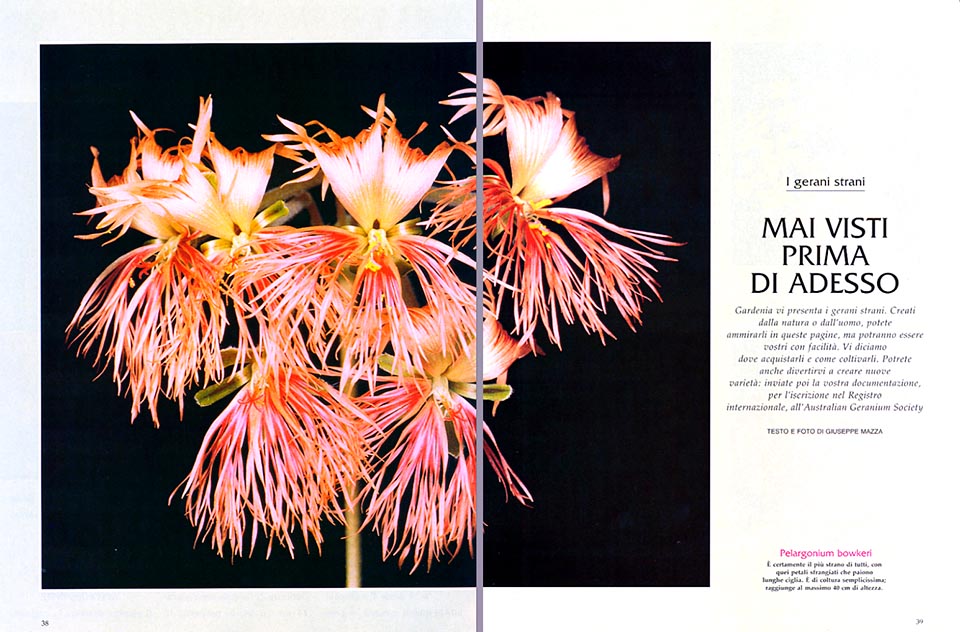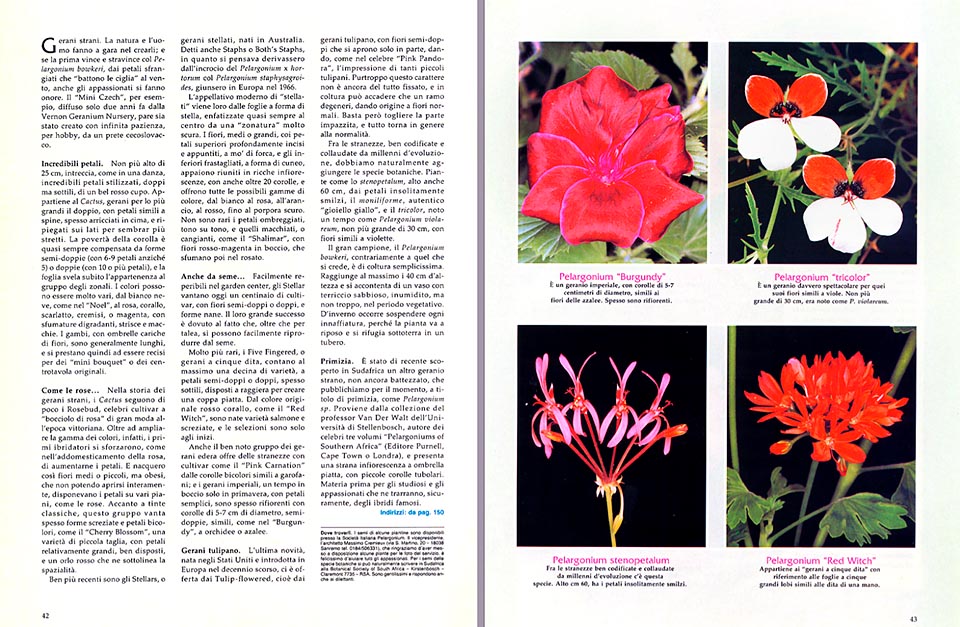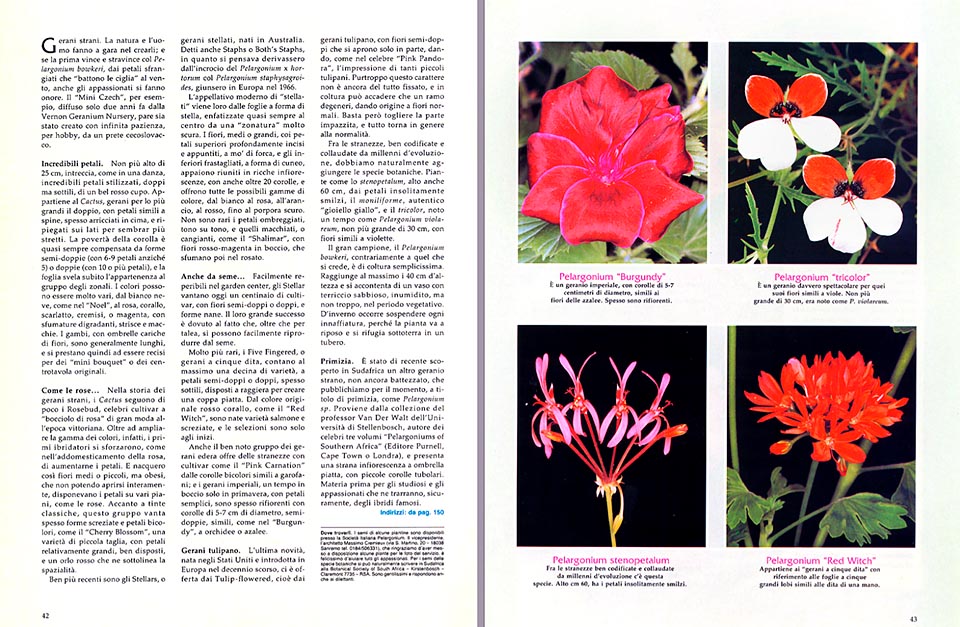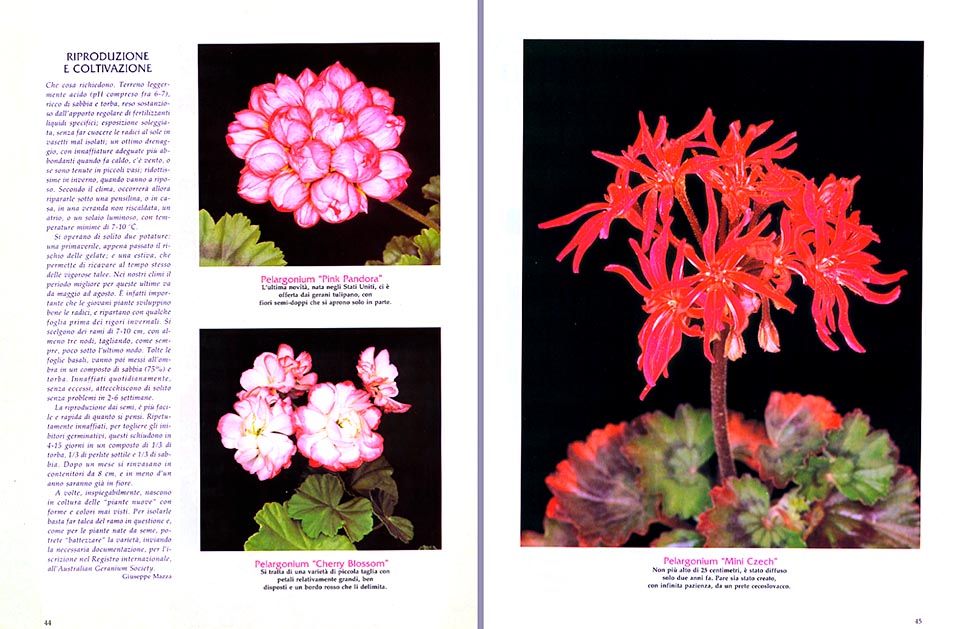Never seen before. Created by man or nature they surprise us with fringed or cactus, tulip, rose shaped petals. Similar to violets and even yellow.





Texto © Giuseppe Mazza

English translation by Mario Beltramini
Quaint Geraniums. The nature and the man compete in creating them; and if the first gains and wins hands down with the Pelargonium bowkeri, with its laciniated petals which “twinkle their cilia” at the wind, also the lovers distinguish themselves.
The ‘Mini Czech’, for instance, propagated only two years ago, by the Vernon Geranium Nursery, seems having been created with endless patience, just for hobby, by a Czechoslovak priest. Not tall more than 25 cm., weaves, as dancing, incredible stylized petals, double, but thin, of a nice dark red colour.
It belongs to the “Cactus”, geraniums mostly great the double, with petals similar to thorns, often curled on the top, and folded on the side, just to look narrower.
The simplicity of the corolla, is almost always compensated by semi-double forms (with 6-9 petals, instead of 5), or double (with 10, or more, petals), and the leaf immediately discloses the membership to the group of the zonal ones.
The colours can be very varied, from the snow white, like in the Noel, to the pink, coral, scarlet, crimson, or magenta, with degrading shades, strips, and spots. The stalks, with umbrellas loaded of flowers, are usually long, and therefore are suitable for being cut for “mini bouquets”, or original centre-pieces.
In the history of odd geraniums, the “cactus” follow closely the “Rosebud”, renowned cultivars shaped, rightly, as a “rosebud”, which were well in fashion in the Victorian era.
In addition, to amplify the range of colours, in fact, the first hybridizers endeavoured, as done for the domestication of the rose, to increase the number of the petals, and so, came to life medium or small, but corpulent, flowers, which, as could not fully open, were disposing them on various levels, like the roses.
Close to the classical dyes, this group has often variegated forms and bi-coloured petals, such as the ‘Cherry blossom’, a variety of small size, with rather large petals, well placed, and a red border which emphasizes its spatiality.
Much more recent, are the “Stellars”, or “Star-shaped Geraniums”, born in Australia, by means of Ted Both, a passionate of geraniums of Sydney. Called also “Staphs”, or “Both’s Staphs”, as they thought they were coming from the cross breed of the Pelargonium hortorum with the Pelargonium staphysagroides, they arrived in Europe in 1966.
The modern appellation of “Stellar”, is not coming to them from the flower, but from the star-shaped leaves, almost always emphasized, at the centre, by a very dark “zone”. The flowers, medium or large, with the upper petals deeply incised and sharpened, like a fork, and the inferior ones, indented, like a wedge, appear united in rich inflorescences, with even more than 20 corollas, and offer all possible ranges of colours, from white to pink, orange, red, up to dark purple. Shaded, tone over tone, petals are not rare, and the spotted, or changing ones, like the ‘Shalimar’, with flowers red-magenta in bud, which then fade in the pink.
Easy to be found in the Garden Centre, the Stellar have nowadays about a hundred of cultivars, with semi-double, or double flowers, and dwarf forms. Their great success is due to the fact that they can be easily reproduced by seed, and not only by cutting.
Much more infrequent, the “Five Fingered”, or “Geraniums with five fingers”, count a maximum of ten varieties, with semi-double or double petals, often thin, and placed, like rays, thus creating a flat cup.
From the original red coral colour, such as the ‘Red Witch’, were born the salmon and speckled varieties, and the selections are just at the beginning.
The history of their name is most tormented. In a first time, they were christened ‘Formosum‘, by Milton Arndt, the American who had discovered them, quite casually, in the courtyard of a hotel, in Mexico, where they were saying that they were coming from Formosa. Then they objected to him that “formosum” was a Latin name, often used to identify the species, and, to avoid misunderstandings, another American, Holmes Miller, proposed the name of “Fingered Flowered”, that is, of “flowers with the shape of fingers”. But nowadays, they prefer to talk of “Five Fingered”, referring to the leaves with five big lobes, resembling to the fingers of a hand.
Also the well known group of the “Ivy Geraniums”, offers some oddities with cultivars like the ‘Pink Carnation’ with bi-coloured corollas, similar to carnations, and the “Royal Geraniums”, once in bud only in springtime, with single petals, are often blossoming again with corollas of 5-7 cm. of diameter, semi-double, similar, like for the Burgundy, to orchids or azaleas.
The last newness, born in USA, and introduced in Europe during the last decade, is given to us by the “Tulip-flowered”, that is, by the “Tulip Geraniums”, with semi-double flowers, which open only partially, giving, like in the famous ‘Pink Pandora’, the impression of several small tulips.
Unluckily, this character is not yet completely “fixed”, and in cultivation, it can happen that a branch “degenerates”, giving birth to normal flowers. It is sufficient, anyway, to cut off the “insane” part, and all, usually, goes back to the normality.
Between the “oddities”, well codified and tested by millennia of evolution, we have, of course, to add the botanical species. Plants like the Pelargonium stenopetalum, tall even 60cm. with the petals unusually slender, the Pelargonium moniliforme, authentic “yellow jewel”, and the Pelargonium tricolor, known once as Pelargonium violaceum, not bigger than 30 cm., with flowers resembling to violets.
The big specimen, the Pelargonium bowkeri, contrarily to what is believed, is of very simple cultivation. It reaches a maximum of 40 cm. of height, and is satisfied with a pot with sandy loam, which is to be moistened, but not too much, during the vegetative period. It is not to be watered in winter, as the plant rests and takes shelter under the ground in a tuber.
Another “odd geranium”, has been recently discovered in South Africa, not yet christened,which we publish for the moment, as a hot news, as Pelargonium sp. It comes from the collection of Prof. Van Der Walt, of the University of Stellenbosch, author of the three celebrated volumes PELARGONIUMS OF SOUTHERN AFRICA, and presents a strange, flat umbrella-like inflorescence, with small tubular corollas. Raw material for students and lovers, who will get from it, we can bet, some famous hybrids.
GARDENIA – 1991
→ To appreciate the biodiversity within the GERANIACEAE family please click here.
